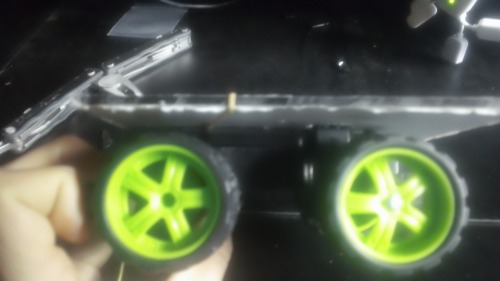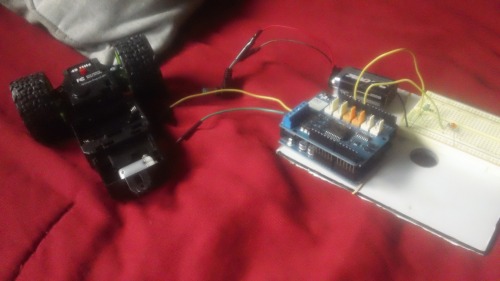My robot is a hacked RC car controled by an Arduino Duemilanove. It has no sensors, but I have left room on my chasis so I can add some more later when I feel more comfortable around Arduino. Most of the time on this project was spent dealing with Arduino code and the motor shield.
The chasis is a $7 RC car that I bought at Walmart. Cheap enough, as I would soon find out. After I stripped everything but the plastic frame, I added a plexiglass flat top that I could place my arduino board and batteries.

I had to trouble shoot a lot in the begining. A good view of the control panel is shown here, with the 9volt battery with an old modem connection tip, the arduino with motor sheild, and simple breadboard. The breadboard shows when the shield has the brake command and which direction the motor is going.

Currently, it can run fine off the floor, but when placed on anything but wood, it does what I call stuttering, and doesn't move. It even does it occasionally on wood as well. This is after I soldered every wire from the motor to the board, so I have ruled out a bad connection. I believe that my problems (outlined in the video) are due to not enough voltage to the motors, but I am not sure how to add more voltage without overloading the arduino, which maxes at 12v.
I have fixed the stuttering problem, thank to birdmun, by adding 4AA batterys to the motor shield. Apparently, the arduino can take multible voltage inputs of over 12v, which I did not know. But now the cheapness of my RC chasis has sunk in. Now the plastic cover that hold the motor and the gears does not properly latch, and the gears are not meshing correctly. I have hit a dead end with this particular chasis, and I now plan to move on to a robot completely designed and built by myself.
Can take simple Forward, backwards, stop commands.
- CPU: Arduino Duemilanove
- Operating system: Windows vista
- Power source: 9 Volt Battery
- Programming language: C
- Sensors / input devices: None.
- Target environment: Wood floor.
This is a companion discussion topic for the original entry at https://community.robotshop.com/robots/show/very-simple-robot


